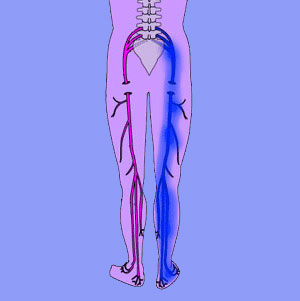
Right side sciatica has a fifty/fifty chance of being the location of any particular case of unilateral sciatic nerve pain. Unilateral symptoms describe expressions in the lower back, buttocks, leg or foot on only one side of the anatomy. This is the diametric opposite of bilateral sciatica which occurs in both legs and/or feet.
There are no universal reasons why a patient may have symptoms only on the right, since the spinal anatomy is identical on both sides. It is more of a patient-specific criterion, based on deterioration or injury of the nerve tissues on the right side of the spinal canal, or some other process, such as piriformis syndrome, which only affects the sciatica nerve on the right.
In essence, besides for a known structural problem which affects just the right side, the patient could just as easily have left side sciatica if the same issue existed on the other side of the spinal canal or muscular anatomy. This is a good guideline for explaining symptoms based on the most commonly implicated process of nerve compression. However, it may not be applicable to cases of central spinal stenosis, since this condition can create a more unpredictable pattern in many patients.
This dialog explores right sided symptoms of sciatica and pseudo-sciatica.
Causes of Right Side Sciatica
Unilateral expressions on either side can be sourced by a large number of possible structural reasons, both spinal and nonspinal. There can also be a completely nonstructural source to blame for unilateral symptoms, such as diabetic neuropathy or even regional ischemia.
Most patients will be diagnosed with a spinal abnormality, such as a herniated disc, osteoarthritis, scoliosis or spondylolisthesis which is theorized to be creating symptoms thorough neurological influence. Structural compression is the most common process, but chemical irritation can also elicit similar symptoms in some patients with annular tears or ruptured discs. Other patients will be proclaimed to suffer from pain due to a non-spinal muscle or bone problem, such as sacroiliac joint degeneration or piriformis syndrome. Regardless of the diagnosis made, statistics clearly show that many patients are incorrectly diagnosed.
One of the more prevalent sources of chronic right side sciatica is certainly oxygen deprivation of the soft tissues, including the muscles, ligaments and nerves, leading to widespread pain, tingling, numbness and weakness in the lower back, legs and/or feet. Ironically, this is also one of the least often diagnosed sources of symptoms, since the condition is generally linked to the mindbody process and therefore flies in the face of the profitable Cartesian medical philosophy. It should be made clear that all these processes can also enact pain on the left, as well as bilateral pain in less common scenarios.
Sciatica Only on the Right Side
In order to enjoy lasting relief from unilateral or bilateral sciatica, it is vital that an accurate diagnosis be made. Most patients who have undergone a wide range of seemingly useful therapy options, without finding success, may have been misdiagnosed, hence explaining why all the sciatica treatments have failed.
The lesson to be learned here is that it is crucial to take part in your own care and do not allow any doctor or therapist to force feed you some ridiculous nonsense about why your pain has not improved. If the treatments fail time and time again, logic dictates that it is probably the diagnosis which is awry, not the effectiveness of the therapy modalities themselves. Always consider this point before seeking additional care for an old diagnosis.
Right Side Sciatica Guidance
Regardless of why you might have sciatica in your right leg, it is important to attack the problem with an enlightened viewpoint. Taking drugs or using any other form of symptomatic treatment as a permanent solution will spell disaster. You must work towards a cure for the symptoms, which means that the underlying causative issue must be discovered, addressed and resolved.
Do not follow any unenlightened advice blindly, even if it comes from your doctor. Remember, some physicians recommend care practices which serve their own best financial interests more than the health requirements of their patients. Instead, get involved in your own treatment and spend some time doing impartial research to help yourself overcome your pain.
Most of all, be extremely wary of sciatica surgeries, since these can make the pain far worse, rather than relieve it, as planned. Most sciatica patients are under the impression that there is something anatomically wrong in their bodies, which requires surgical correction, when in fact, this is rarely the case. Surgery can do permanent damage where none existed before, making a full recovery unlikely.





